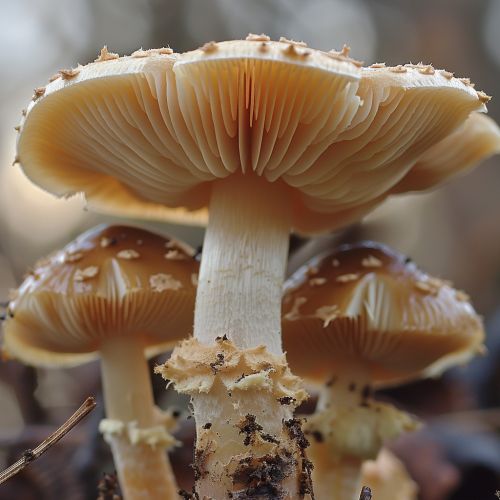Agaricus
Taxonomy and Naming
The genus Agaricus is a member of the family Agaricaceae within the order Agaricales. The name Agaricus was first given by Carl Linnaeus in his seminal work Species Plantarum, published in 1753. The name is derived from the Greek word 'agarikon', meaning 'a kind of tree fungus'. There are approximately 300 species within the genus, which are primarily characterized by their gilled mushrooms.


Description
Agaricus species are typically medium to large in size, and are often found in meadows, pastures, and woodland environments. The fruiting bodies, or mushrooms, of Agaricus species are characterized by a cap that is initially hemispherical before flattening out with maturity, and a stout stem. The gills are free from the stem and densely packed, initially pink before turning chocolate brown as the mushroom matures. The spore print is also brown. Many species also have a ring, or annulus, around the stem, which is the remnant of the partial veil that initially covers the gills as the mushroom matures.
Distribution and Habitat
Agaricus species are cosmopolitan, being found in both temperate and tropical regions of the world. They are most commonly found in grasslands, meadows, and woodlands, but can also be found in a variety of other habitats. Some species are saprophytic, meaning they obtain their nutrients from decaying organic matter, while others are mycorrhizal, forming symbiotic relationships with plants.
Ecology
The ecological role of Agaricus species is primarily as decomposers and as symbiotic partners with plants. As decomposers, they play a crucial role in nutrient cycling by breaking down organic matter and returning nutrients to the soil. As mycorrhizal partners, they form mutualistic relationships with plants, aiding in nutrient uptake.
Edibility and Uses
Many species within the Agaricus genus are edible and are popular for their culinary uses. The most well-known of these is Agaricus bisporus, commonly known as the button mushroom, which is cultivated worldwide for consumption. However, some species are poisonous and can cause various symptoms if ingested, including gastrointestinal distress and hallucinations. Therefore, correct identification is crucial when foraging for Agaricus mushrooms.
Species
There are approximately 300 species within the Agaricus genus. Some of the more well-known species include Agaricus bisporus, Agaricus campestris (the field mushroom), and Agaricus xanthodermus (the yellow-staining mushroom). Each species has its own unique characteristics and habitat preferences.
